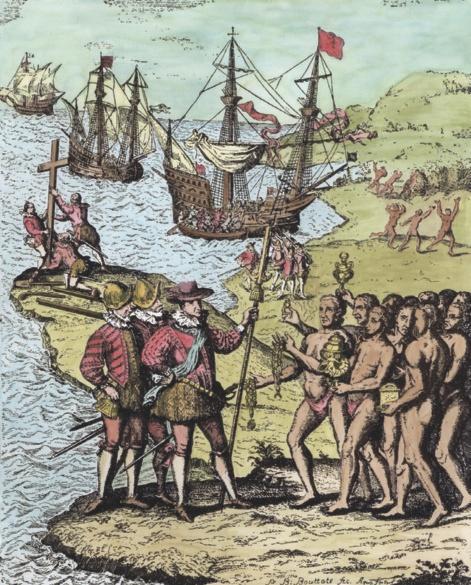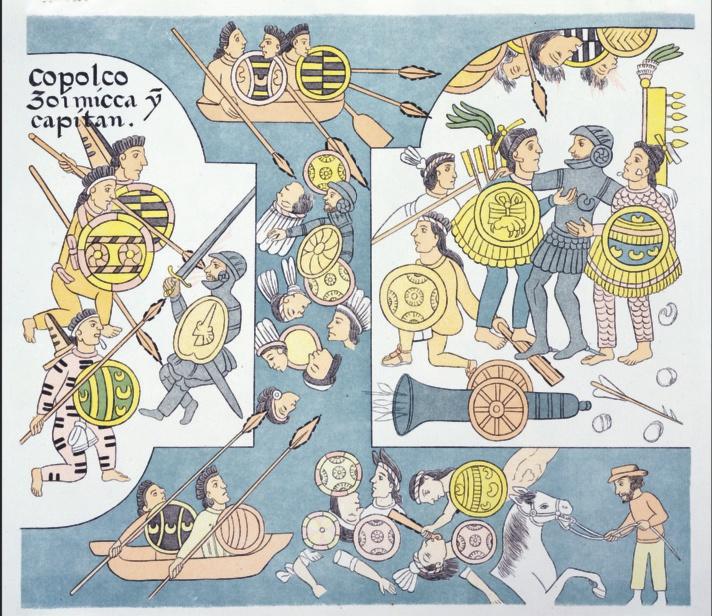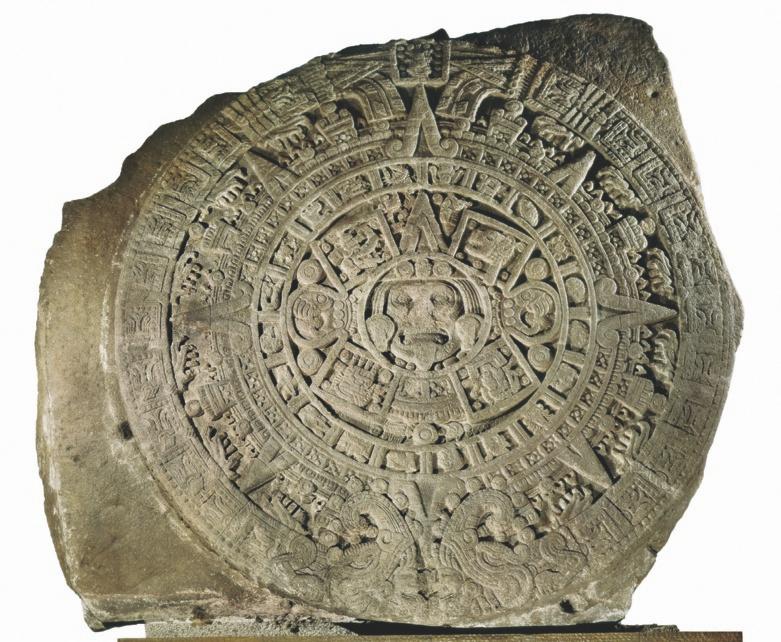
8 minute read
Spain conquers America 3 1
source 17 Sailing west
I commend you on your plan to sail to the west and I am sure, as you have already seen on my map, that the route you wish to take is not as difficult as people think. On the contrary, the course plotted by me is most certain. You would also entertain no doubt if you had met many people who have been in those countries. You are sure to find powerful kings there and many densely populated and prosperous cities and countries, which possess many types of precious stones. It will greatly please the rulers there if we educate them in the Catholic religion and all our sciences.
Paraphrased from: Toscanelli’s letter to Columbus, circa 1480.
On board the Santa Maria
Spain follows Portugal
Like the Portuguese, the Spaniards also wanted to discover new lands and gain vast profits from trade. That happened in 1492, when there was enough money and time to invest in a new enterprise. That year the Spaniards won their centuries-long struggle against the Islamic presence in the Iberian Peninsula (the Reconquista) and the Spanish King Ferdinand and his wife Isabella decided to follow Portugal’s example. The Genoese navigator Christopher Columbus was given Spanish backing for a voyage to discover a sea route to the Indies heading west across the Atlantic. Scholars, including the cartographer Toscanelli, had convinced Columbus that this was possible. Toscanelli’s map showed that you could reach Asia by crossing the Atlantic Ocean.
Based on the journal that Columbus kept, we can reconstruct life aboard the Santa Maria. “When you walk into the captain’s cabin, you will see an impressive man, Juan de la Cosa, sitting to the left of Captain Columbus. He is both the ship’s owner and its navigator. One of the most important duties on board a ship is navigation, determining the course to be maintained. In front of De la Cosa there is a map by Toscanelli and instruments such as the astrolabe and compass, essential for navigating the seas. The other man at the table is Luis de Torres, an interpreter who has been brought along to talk to the locals.
The deck, the fore deck and the hold are also hives of activity. Here for example, you will find the cook and the steward in charge of the food stores and the ship’s rations. Over there is Dr Juan Sanchez, examining a wound sustained by one of the cabin boys. Do you see the crates of weapons in the corner? Be careful not to touch them. The muskets and cannon are checked every day by Diego de Arana, the weapon master.
There is plenty of food available, with large quantities of dried legumes and cereals, hardtack, salted meat and dried fish. It is enough to feed the whole crew for one year. The ship’s hold also contains chests of trinkets, glass, iron and copper, to exchange or give away. The man standing next to one of the chests is goldsmith Cristobal Caro. He hopes that those chests will be filled with gold on the return voyage.
The success of Columbus

In 1492, Columbus departed with three ships. In October of that year, the explorers sighted land. Columbus went ashore. He called the people there ‘Indians’ because he thought he was in the Indies. Columbus named the territory San Salvador, another name for Jesus meaning Holy Redeemer. He wrote about the discovery in his journal.
At the end of 1492, Columbus sailed back to Spain to tell the king and the queen about his discoveries. He had to convince the Spanish rulers that his expedition had been a success. Columbus announced that the western route to the Indies had been found and would bring the Spaniards great wealth (Source 19).
Source 18
San Salvador
At two o’clock in the morning we sighted land. Before long we saw naked people along the shore. The admiral went ashore in the armed sloop. The admiral had the royal standard with him and the captains each had a flag bearing a green cross and the letters F and Y, with a crown above each letter. We saw green trees, many pools and all kinds of fruits. The admiral claimed the island for the king and queen by issuing the proper proclamations.
Paraphrased from: Columbus’s Journal, 1492-1493.
Around the world with Magellan
At the beginning of the sixteenth century, Portuguese sailors discovered the Moluccas and other islands in the Indonesian archipelago. They had never sailed this far east before. The Moluccas were very rich in spices (especially cloves), so investors were eager to finance new expeditions to these islands. The discovery of the Moluccas led to a dispute with Spain. In the Treaty of Tordesillas, dating from 1494, Portugal and Spain had divided the undiscovered parts of the world between them: everything west of Cape Verde (island group off the west coast of Africa) would come under Spanish rule, while everything to the east would belong to Portugal. After the Portuguese discovered the Moluccas, the Spanish began to have their doubts. Shouldn’t these islands belong to them?
After all, wouldn’t it be possible to sail west and reach the islands from the other side? The experienced Portuguese navigator Ferdinand Magellan was daring enough to try.
On behalf of the German Emperor Charles V, who was also King of Spain, he sailed from the city of Seville in 1519 on an expedition that involved five ships and 250 crew members and was financed by the Fuggers, a wealthy family of German bankers. The Italian nobleman Antonio Pigafetta went along and wrote an account of the hardships during the voyage, the flora and fauna, and the foreign peoples the explorers encountered.
source 19
Kaapverdische Eilanden
Voyages of Cortés to Mexico to Tenochtitlan
Voyages of Pizarro first expedition 1524 - 1525 second expedition 1526 - 1528 third expedition 1530 - 1534
Voyages of Columbus first expedition 1492 - 1493 second expedition 1493 - 1496 third expedition 1498 fourth expedition 1502 - 1504 viceroyalty of New Spain viceroyalty of Peru

Voyages of discovery to the New World, with the Spanish viceroyalties of New Spain and Peru.
source 20 Gold galore
There are unlimited supplies of gold. Your Highnesses can see that I will give them all the gold they need, all spices and as much cotton as Your Majesties order me to bring aboard, and of which Your Majesty will be able to sell as much as he wants, and pagan slaves. I have also found cinnamon and will also secure thousands of other important commodities.
Paraphrased from: Columbus’s Journal, 1492-1493.
Conquistadors
Once Columbus had made clear the opportunities that lay waiting in the territories he had discovered – the New World – adventurers crossed the Atlantic to make their fortune. These adventurers were called conquistadors, which means conquerors. They headed into the interior, fought the indigenous peoples and claimed vast tracts of land in the name of the Spanish king. The Spaniards were able to win these battles with a small number of soldiers because they possessed weapons and military technology unknown to the indigenous peoples, such as iron swords, helmets, armour, firearms and riders on horseback. The conquistadors also formed alliances with some indigenous groups in order to defeat others.
Source 21
Aztec spies talk about their encounter with the Spaniards

Their battle gear is all made of iron: they dress in iron, they wear an iron cap, carry iron shields and lances. They sit on the back of their ‘deer’ which are as tall as roofs. Their entire body is covered and only their face is visible. They are white as chalk. They have yellow hair, although some are dark. Their beards are long and also yellow, as are their moustaches.
Their hair is frizzy and thin, rather like embroidery. Their dogs are huge and overwhelming, with wavy ears and big, drooping tongues. These animals have intense yellow eyes, that shoot sparks and their hollow bellies are long and ribbed. They are strong and robust, restless, and run panting with their tongues hanging from their mouths. Spotted as jaguars they are, with spots of all different colours.
Paraphrased from: Bernardino de Sahagún, General History of the Affairs of New Spain, 1540-1569.
Aztecs
Around 1500 many different ethnic groups lived on the American continent, each with their own customs, language and culture. At this time, Mexico was home to the Aztecs, a people that had subjugated many other peoples in the fifteenth century. The Spaniards appeared just as the Aztec civilization had reached its peak. Spanish soldiers marvelled at the Aztec cities. These cities floated on water and their temples towered above them. Trade was very active.
Source 22
Battle between the Spanish explorer and conqueror Hernando Cortes (1485-1547) and the Aztec leader Cuauhtemoc at the city of Tenochtitlan in 1521. Illustration from the Mexican illustrated history Lienzo de Tlaxcala dating from circa 1550.
Artisans made beautiful and useful artefacts. The religious ceremonies made a deep impression: the Aztecs sacrificed human hearts to their gods. The leader of the Aztecs was called Montezuma and the Aztecs saw him as their god.
In 1519, the Aztecs came into contact with Hernán Cortés. Cortés had crossed from Cuba to the mainland of South America with approximately 500 soldiers. He wanted to discover riches and claim territory in the name of the Spanish king. Cortés soon managed to defeat the Aztecs. He was helped by coincidence. The Aztecs believed in the legend that the god Quetzalcoatl would one day return to them. Because Cortés made such a mighty impression on them, the Aztecs thought he might be the deity they were waiting for and so they received the Spaniards with great reverence. But in 1521, the Spaniards conquered the Aztecs with military force, with the help of the indigenous peoples who had previously been defeated and oppressed by the Aztecs. The Aztec civilization was destroyed and Cortés became the governor of Mexico.
Incas
The west of South America was home to another great empire. It belonged to the Incas, a civilization that had emerged in the mountainous Andes region from the thirteenth century. The Incas had expanded their power by forming alliances with other peoples or by defeating them in battle. In order to govern their vast empire, which stretched from Ecuador deep into Chile, the Incas had established a communication system. Couriers travelled source 23 through the country at great speed on paved roads up to 15,000 kilometres long, delivering messages and orders from the administrative centre of Cusco. These roads were also used by armies. The Incas worshipped their ancestors and preserved them as mummies. They believed in life after death and regarded the sun and the moon as gods. The sun god Inti was the chief god and the ancestor of the Incas. Solar festivals were held in his honour. The government was led by the Inca, who was seen as an incarnation of the sun god.
Aztec solar calendar from the fifteenth century. The image in the centre is the face of the sun god Tonatiuh. He is holding human hearts in his claws while calling out for human sacrifices with his outstretched, razor-sharp tongue. He is surrounded by the four ages of Aztec history and circles with signs that refer to the days of the month and the corners of the earth.

Pizarro defeats the Inca Empire
Spanish conquistador Francisco Pizarro first came into contact with the Incas in 1526. The Spaniards saw “many silver and gold, bracelets, armour, beads and precious stones, mirrors decorated with silver, large and small bowls; there were cloaks of wool and cotton, emeralds and other precious stones and pieces of crystal.” Pizarro was eager to conquer the territory and demanded to meet Atahualpa, the Inca leader. The Inca agreed to meet him unarmed, hoping that the Spaniards would be so impressed by the Incas that they would keep the peace. But Pizarro was not that impressed and took Atahualpa prisoner. He forced the Inca to tell him where he had hidden his gold. Atahualpa was eventually killed and Pizarro conquered the entire Inca Empire with little resistance.









